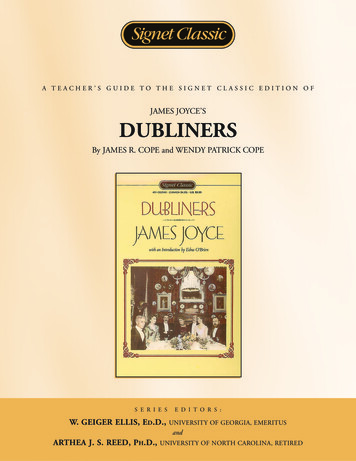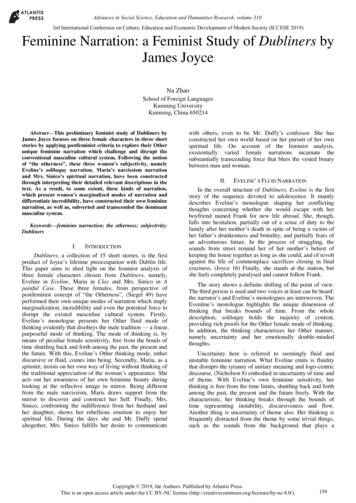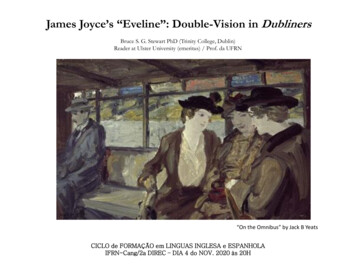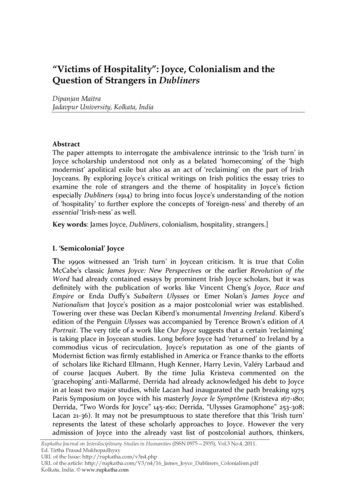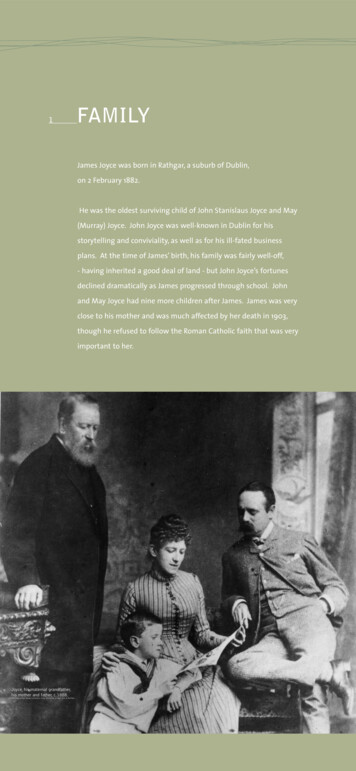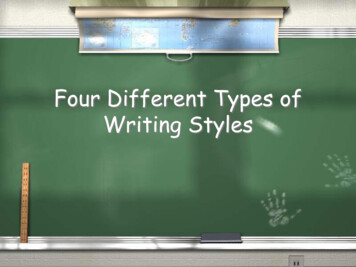
Transcription
ISSN 1799-2591Theory and Practice in Language Studies, Vol. 9, No. 10, pp. 1287-1292, October 2019DOI: http://dx.doi.org/10.17507/tpls.0910.04Narrative Innovation in Dubliners and JamesJoyce’s Exilic ExperienceChenglin YuShanghai International Studies University, Shanghai, ChinaAbstract—James Joyce’s Dubliners betrays a narrative innovative tendency towards the restriction of point ofview, which means the narration tends to unfold through the character’s point of view without omniscientinterference. After examining the short stories in the context of their creation, we assert that Joyce’s exile andDubliners’s censorship mostly account for this formal innovation. Further exploration shows that therestriction of point of view is actually a narrative strategy Joyce deploys to convey his ambiguous andambivalent feelings towards his homeland and compatriots triggered by his exilic experience.Index Terms—James Joyce, Dubliners, narrative, point of view, exile, censorshipI. INTRODUCTIONIt is generally acknowledged among the Joyceans that free indirect discourse is a typical stylistic trait of Joyce’sworks. To see this formal trait in terms of narrative, it can be perceived as a tendency of restriction of point of view inwhich the narrator gets rid of omniscient comments and judgements in the narration so that it is filtered through thecharacter’s point of view. After a close examination of Joyce’s creation of Dubliners, we trace the origin of thisnarrative innovation in his revisions of this early work. The excavation of Dubliners’s creating process further revealsthat Joyce’s exilic experience is responsible for this narrative innovation. So the key question is raised: How doesJoyce’s exilic experience lead to his narrative innovation in Dubliners?Previous studies shed light on the question from various perspectives. Warren Beck in Joyce’s Dubliners: Substance,Vision, and Art (1969) holds that the main narrative traits of Dubliners such as the self-effacement of the narrator, openendings, epiphany, absence and ellipsis in narration, etc. are a result of Joyce’s ambivalent feelings of affection andaloofness towards his subject-matter. Beck’s approach and insight inspires us to probe the complexity of narrative pointof view in Dubliners in connection with Joyce’s exilic experience. In “Nostalgia and Rancor in ‘Dubliners’” (2011) andJames Joyce and the Exilic Imagination (2015), Michael Patrick Gillespie advocates examining the complexconnotations of Joyce’s works in relation to his exile. Accordingly, he maintains that Joyce’s conflicting feelings of“nostalgia and rancor” towards his homeland caused by exile are implicated in his narrative. Gillespie doesn’t touchupon the exact narrative forms effected by the double feelings in this book. But his early monography Reading the Bookof Himself: Narrative Strategies in the Works of James Joyce (1989) contributes great ideas. With free indirectdiscourse as the focus of research, Gillespie argues that this stylistic trait is originated from the censorship Dublinerssuffered in its publication. As a narrative strategy, free indirect discourse has the effect of ambiguity and uncertaintywhich transfers the responsibility of interpretation to the reader. Although the relationship between Dubliners’s formalinnovation and its censorship is not the main task of the research, it hints us, along with the above-mentioned works, toconnect Dubliners’s narrative form with Joyce’s experience of exile and censorship. This paper is intended to explore inlight of the texts of the short stories and Joyce’s biographical documents the following topics: 1. the creation andcensorship of Dubliners; 2. the restriction of narrative point of view in revisions of Dubliners; 3. the relationshipbetween Joyce’s exilic experience and the narrative innovation.II. CREATION AND CENSORSHIP OF DUBLINERSThe writing of the short stories of Dubliners began in 1904 when Joyce wandered aimlessly at home after hismother’s death. His friend George Russell (AE), who sympathized with his plight and admired his talent, offered himthe chance to write “a short story suitable for the Irish Homestead, something ‘simple, rural?, livemaking?, pathos?[pathetic]’ which would not shock his readers” (Ellmann, 1982, p. 163) to earn some money. Joyce accepted the offerand successively wrote “The Sisters,” “Eveline,” and “After the Race.” The editor published the three stories, but toldJoyce not to submit any more since they had received many letters of complaint from the readers (Ellmann, 1982, p.165). In fact, Irish Homestead is an agricultural newspaper, featuring stories of rural and local colors of the Irish west.The style of Joyce’s stories is an obvious discord. Actually, he had always despised the newspaper and was ashamed ofpublishing in “the pigs” paper (Ellmann, 1982, p. 164) for livelihood. From October 1904 when Joyce left Ireland toNovember 1905, Joyce completed 12 stories, compiled them into Dubliners, and sent it to the English publisher GrantRichards. In February 1906, Joyce sent an additional story “Two Gallants.” It was this story that incurred disaster andpostponed the publication of Dubliners for eight years. When Joyce was ready to send “A Little Cloud” in April 1906, 2019 ACADEMY PUBLICATION
1288THEORY AND PRACTICE IN LANGUAGE STUDIESRichards told him the printer’s objection to “Two Gallants” and some other stories, asking for changes on themanuscript (Ellmann, 1982, pp. 219-220). Negotiations between Joyce and Richards via letters over disputes about therevision lasted until September, ending with Richards’s rejection of publishing (Ellmann, 1982, p. 231). Later, during1906 and 1907, Joyce continued to compose the last story “The Dead” and finally contracted with the Dublin publishersMaunsel & Co. for Dubliners in 1909. Unfortunately, again, after prolonged negotiations and compromises, GeorgeRoberts of Maunsel & Co. decided not to publish Dubliners for reason of its anti-Irish implications (Ellmann, 1982, p.330). But Roberts offered to sell Joyce the sheets. However, the printer John Falconer refused to give the unpatrioticsheets and destroyed them. Angered and agonized, Joyce left Ireland the same night and never came back again(Ellmann, 1982, pp. 335-337). Until 1914, Joyce got in touch with Grant Richards again who finally brought outDubliners thanks to the loosened censorship.Many scholars unanimously believe that the bitter censorship Dubliners suffered to a great extent motivated Joyce tomake self-conscious formal innovation in his repeated revisions of the stories. For example, Paul Vanderham in JamesJoyce and Censorship (1998) asserts that “censorship was directly responsible for Joyce’s growing sense of exile”(Vanderham, 1998, p. 60), and “Joyce’s early conflicts with the censor engendered what may be described as the styleof exile that Joyce began to develop early in 1907, shortly after Grant Richards refused to publish Dubliners (on 26October 1906)” (Vanderham, 1998, p. 62). The “style of exile” in Vanderham’s words exactly refers to his artisticambiguity and uncertainty. Similarly, Gillespie in Reading the Book of Himself also argues that Grant Richards’scensorship of Dubliners coincidentally occasioned Joyce’s formal innovation. The formal development referred to byGillespie is the free indirect discourse. Joyce’s revisions of the texts suggest “that something beyond a desire to mollifyhis publisher motivated Joyce,” “while Richards’s censoriousness acted as an important goad for revision, it wasJoyce’s own emerging artistic maturity that stood as the shaping force behind the changes” (Gillespie, 1989, p. 34). Tomake it brief, Joyce took the opportunity of revision in response to the censorship to develop his formal innovation.From Joyce’s negotiating letters with Richards, we know that Richards mainly censored three stories—“Two Gallants,”“Counterparts,” and “An Encounter” for their immoral contents and indecent language①. However, the major revisionsJoyce made during that period were on the texts of “The Sisters,” “Eveline,” and “The Boarding House.”② This alsoindicates that censorship serves as a chance for Joyce’s formal innovation. If so, what is the deeper motivation for thisself-conscious artistic development? To answer the question, we first need to anatomize the specific narrativeinnovation in Joyce’s many revisions of Dubliners.III. RESTRICTION OF NARRATIVE POINT OF VIEW IN REVISIONS OF DUBLINERSTo probe Joyce’s narrative innovation in Dubliners, it’s vital to closely examine revisions in various versions of thetexts from the first draft of the stories (1906) to the first edition of the book (1914). As is mentioned above, the texts of“The Sisters,” “Eveline,” and “The Boarding House” are the most revised. With these three stories as research object,we trace the details of different revisions and discover a significant innovative tendency towards the restriction ofnarrative point of view.After Richards rejected the publication of Dubliners, Joyce revised the text of “The Sisters” extensively (Scholes,1964, p. 109). As a result, the final published version of “The Sisters” has varied greatly from the first Irish Homesteadversion③. According to Florence L. Walzl’s research, in the first version, the narration unfolds in a highly realisticmanner. The description of facts and details is on the verge of verisimilitude. For example, Father Flynn’s “progressionfrom childhood eccentricity to adult abnormality” is consistently and clearly explained so that no mystery, vagueness,or “gnomon” which characterize the later versions exist (Walzl, 2012-2013, p. 77). Although the boy is the narrator, hismind “tends to give a mirror reflection of the flat reality of Father Flynn’s life: the facts are as they are” (Walzl,2012-2013, p. 87). The narrator also gives direct comments here and there. For instance, he feels that the priest “had anegoistic contempt for all women-folk, and suffered all their services to him in polite silence” (Walzl, 2012-2013, p. 79),and he asserts that “the priest’s reading his prayerbook is ‘make-believe’ because he is always found asleep over it”(Walzl, 2012-2013, p. 80). In contrast, in the final version, everything becomes uncertain. The narration is restricted tothe boy narrator’s point of view, from which only fragmented observations are presented. Much precise information inthe first version is omitted or obscured. There’s no longer “presentation of actual facts or any rational evaluation”(Walzl, 2012-2013, p. 89). As for Father Flynn’s real physical and mental status, readers can only infer or surmise fromthe objective presentation of outer phenomena since no definite description is given. From the boy’s narration, we candeduce symptoms of paralysis on the priest, but barely have any inkling of its causes. The absence and silence in the①See James Joyce, Selected Letters of James Joyce. Ed. Richard Ellmann. New York: The Viking Press, 1975, pp. 78-90; Robert Scholes, “GrantRichards to James Joyce.” Studies in Bibliography 16(1963), pp. 139-160.②About specific changes in different versions of single stories of Dubliners, see Robert Scholes, “Some Observations on the Text of ‘Dubliners’:‘The Dead’.” Studies in Bibliography 15(1962), pp. 191-205; Robert Scholes, “Further Observations on the Text of ‘Dubliners’.” Studies inBibliography 17(1964), pp. 107-122; Florence L. Walzl, “Joyce’s ‘The Sisters’: A Development.” James Joyce Quarterly 50.1-2(2012-2013), pp.73-117.③About the detailed revisions of “The Sisters,” see Marvin Magalaner, Time of Apprenticeship: The Fiction of Young James Joyce. London,New York: Abelard-Schuman, 1959, pp. 72-87; Marvin Magalaner and Richard M. Kain. Joyce: The Man, The Work, The Reputation. Westport:Greenwood Press, Inc., 1979, pp. 82-87. 2019 ACADEMY PUBLICATION
THEORY AND PRACTICE IN LANGUAGE STUDIES1289narrative invites diverse interpretations, which renders it uncertain and ambiguous. Walzl puts it well when she saysthat Joyce’s “restriction of the point of view to the mind of the boy allowed for exclusion of much explanatory andbackground material as outside the youth’s frame of reference. It made legitimate the use of inference and suggestionwhere we might otherwise anticipate explanation and statement” (Walzl, 2012-2013, p. 106).The text of “Eveline” also undergoes fairly extensive changes from the Homestead version to the first edition ofDubliners. One subtle change is that some words and phrases used to narrate Eveline’s reverie are replaced with onesmore appropriate for the character (Scholes, 1964, p. 111). To take one example, in describing Eveline’s nostalgicfeelings towards her home, the Homestead version and the late Maunsel version respectively unfold as follows:Home! She looked round the room, passing in review all its familiar objects. How many times she haddusted it, once a week at least. It was the “best” room for ten years—more—twelve years, and kneweverything in it.Home! She looked round the room reviewing all its familiar objects which she had dusted once a weekfor so many years, wondering where on earth all the dust came from. Perhaps she would never see againthose familiar objects from which she had never dreamed of being divided (Scholes, 1964, p. 112).Comparing these two paragraphs, we can feel that the language of the bottom paragraph is more suitable to Eveline’smind and diction. In his revision, Joyce inclines to restrict the narration to Eveline’s focalization so that the discourse ofthe narrator and character are fused. Robert Scholes puts the narrative innovation in this way: “Through countless littlechanges of this kind, Joyce carefully eliminated his own personality from Dubliners, as he developed a system wherebythe events and characters presented in the narrative rather than any assumed narrative persona determine the diction andsyntax of the narrative prose” (Scholes, 1964, p. 113). This is close in meaning to “the Uncle Charles Principle”④ putforward by Hugh Kenner, which can be seen as a prefiguration of Joyce’s free indirect discourse.Similar revisions can be detected in the text of “The Boarding House.” Scholes’s research shows that “in eightsignificant substantive changes the intent is obviously to make the language more colloquial, more appropriate to theevents being narrated than to the more lofty tone of the narrative persona” (Scholes, 1964, p. 115). In addition, he alsopoints out a significant addition of ten lines in the narration which generates an effect of ambivalence and ambiguity.The following lines are added in the narration of the night when Polly came to Mr. Doran’s room and they had sex:Then late one night as he was undressing for bed she had tapped at his door, timidly. She wanted torelight her candle at his for hers had been blown out by a gust. It was her bath night. She wore an opencombing jacket of printed flannel. Her white instep shone in the opening of her furry slippers and theblood glowed warmly behind her perfumed skin. From her hands and wrists too, as she lit and steadiedher candle a faint perfume arose (Scholes, 1964, p. 116).The added description of Polly’s attire and action bears an implication of seduction. But there’s neither definitestatement nor detached judgment in the narration, just objective description of phenomena, so the truth remainsvague—the readers aren’t sure either Polly or Mr. Doran is the victim. Margot Norris visually summarizes this typicalnarrative trait of Joyce’s as the “narrative bread pudding,” which means the narration tends to present a crust withoutsubstance (Norris, 2003, p. 93).Through the above anatomy, a tendency of the restriction of point of view made a figure in Joyce’s revisions of theDubliners stories. This narrative innovation produces a consistent effect of uncertainty and ambiguity. Why does Joycemake such a formal innovation to achieve such an expressing effect? His exilic experience and status is counted as amajor contributing factor.IV. AMBIVALENT FEELINGS OF THE E XILIC ARTIST AND NARRATIVE INNOVATIONSince censorship is the direct cause of Joyce’s revisions, his narrative innovation can first of all be regarded as astrategy to cope with the censorship. The restriction of narrative point of view engenders effect of ambiguity anduncertainty through which the moral responsibility is shifted to interpretations of the reader. However, the deepermotivation of this innovation is attributed to Joyce’s ambivalent feelings towards his subject-matter as an exilic artist.Joyce has always been notorious for his harshness on his hometown and fellow people for his unrelenting fightagainst the religious and social force in Ireland and blatant criticism of the fatuousness of the Irish people. However,many scholars point out the flip side. For example, Beck believes that “in his very aloofness Joyce was mostinvolved Beneath the cold distaste, unsparing in its satire of a culture and a local society, are tokens of hidden griefand recurrent secret conflict (Beck, 1969, p. 5). Gillespie also sees double feelings in Joyce’s heart as an exile when hesays that “over the course of his time abroad, Joyce amply demonstrated the ambivalence—oscillating between rancorand nostalgia—felt by many exiles, balancing criticisms with outbursts of sentimental longing and national pride(Gillespie, 2015, pp. 20-21). In his exilic years on the Continent, his constant writing theme is Ireland. Actually he hascherished nostalgic feelings for Ireland all along. In a letter to his brother Stanislaus Joyce on September 25, 1906, hewrote: “I have never felt at my ease in any city since I left it except Paris” (Selected Letters, pp. 109-110).④It refers to the integration into the narrative voice the linguistic traits of the character, see Hugh Kenner, Joyce's Voices. Berkeley, Los Angeles,London: University of California Press, 1978. 2019 ACADEMY PUBLICATION
1290THEORY AND PRACTICE IN LANGUAGE STUDIESJoyce’s thrice returns to Dublin between 1909 and 1912 agitated his conflicting feelings towards his hometown, ascan be shown from the biographical records and Joyce’s letters during that time. His biographer Richard Ellmannclaims that “the agitation of Joyce’s feelings during his visit to Dublin in 1909 laid bare for a moment topics of thatconversation with himself One was his bond to Dublin” (Ellmann, 1982, p. 292). Joyce’s indispensable bond toDublin or Ireland is embodied in the fact that “he could not exist without close ties, no matter in what part of Europe heresided; and if he came to terms with absence, it was by bringing Ireland with him, in his memories, and in the personsof his wife, his brother, his sister.” “So in later life, when asked if he would go back to Ireland, he could reply, ‘Have Iever left it?’” (Ellmann, 1982, p. 292). On the other side, in his letters to Nora during his home-return, he repeatedlyvented his distaste for the city and its dwellers, and his annoyance among them. He said,How sick, sick, sick I am of Dublin. It is the city of failure, of rancor and of unhappiness. I long to be outof it (Selected Letters, p. 163).I feel the day all wasted here among the common Dublin people whom I hate and despise (SelectedLetters, p. 172).I loathe Ireland and the Irish. They themselves stare at me in the street though I was born among them.Perhaps they read my hatred of them in my eyes. I see nothing on every side of me but the image of theadulterous priest and his servants and of sly deceitful women. It is not good for me to come here or to behere (Selected Letters, p. 174).From the above materials, we can feel a violent clash of love and hate in Joyce’s mind. It is highly likely that theagitated confliction of feelings during that time catalyzes his narrative innovation, especially when the main innovationis on the point of view. That’s because the exile status gives the writer a unique double vision: “it enables the exile bothto enjoy an intimate sense of the country of origin and to experience a reflective detachment pulling any number ofissues into perspective (Gillespie, 2015, p. 10). To integrate the double vision into artistic form, Joyce thus skillfullyrestricts the narrative point of view and employs free indirect discourse, both to the same purpose. How does the doublevision or ambivalent feelings function in the narrative innovation? It will be elucidated in the following on the basis ofan anatomy of the text revision.In July 1904, Joyce stated in a letter to his friend C. P. Curran his intention in writing a collection of short storiescalled Dubliners: “I’m writing a series of epicleti—ten—for a paper. I have written one. I call the series Dubliners tobetray the soul of that hemiplegia or paralysis which many consider a city” (Selected Letters, p. 22). At that time, Joycehadn’t left Ireland yet and just began to write stories for the Irish Homestead. The statement shows that Dubliners bearsa moral purpose at the beginning of its creation: to reveal the paralytic soul of a city. In 1906 when Dubliners wasprepared to be published, Joyce again repeatedly claims the purpose of this book in letters to Grant Richards, likeMy intention was to write a chapter of the moral history of my country I have written it for the mostpart in a style of scrupulous meanness (Selected Letters, p. 83).I have taken the first step towards the spiritual liberation of my country (Selected Letters, p. 88). you will retard the course of civilization in Ireland by preventing the Irish people from having onegood look at themselves in my nicely polished looking-glass (Selected Letters, pp. 89-90).All these aim at a bitter lash of the country and people. However, his later revisions of the stories evinced amellowing of feelings.Take “The Sisters” as an example. A generally held confusion among readers of the story is that: why does a story ofa priest and a boy use the title of “the sisters”? Walzl’s research throws light on the question in that she found the sistersloomed large in the Homestead version while later revisions shifted focus to the boy and the priest (Walzl, 2012-2013,pp. 78-79). This implies that Joyce in his revision pushes the role of the sisters from center to margin. Along with thisshift is a conversion of artistic technique from realism to impressionism. In the Homestead version, the narratorchronicles in detail how the sisters self-sacrificingly serve their priest brother while on the other hand describes thepriest’s indifference and contempt to the sisters. It not only clearly states the fact that the sisters are physically damaged,ignorant, and fatuous, but makes direct comments on the unequal relation. In Walzl’s view, the image of the sisters inthe Homestead version symbolizes “the laity, pious and poor, ignorant or deaf” who sustain the clergies at their ownsacrifice (Walzl, 2012-2013, p. 79). This shows that in the first draft of the story, Joyce took on the look of a rebel asalways, relentlessly satirizing his fellow Dubliners. Thus, the sisters, “in their complacent ignorance which uncriticallylives and endures by half-answers they illustrate a classic form of the paraplegia Joyce diagnosed in Dubliners andsought to hold a mirror to” (Beck, 1969, p. 60). However, in the final version, the image of the sisters is obscured. Forexample, in the mourning scene, when the boy and his aunt arrived at the priest’s house, Nanny came out to receivethem. The boy narrator describes the scene as follows:“as it would have been unseemly to have shouted at herm my aunt shook hands with her for all. The oldwoman pointed upwards interrogatively and, on my aunt’s nodding, proceeded to toil up the narrowstaircase before us, her bowed head being scarcely above the level of the banister rail (Dubliners, p.7).When they knelt down on the ground to pray, he continues the narration:I pretended to pray but I could not gather my thoughts because the old woman’s mutterings distracted me.I noticed how clumsily her skirt was hooked at the back and how the heels of her cloth boots weretrodden down all to one side (Dubliners, p.8). 2019 ACADEMY PUBLICATION
THEORY AND PRACTICE IN LANGUAGE STUDIES1291It is from the boy’s restricted observation that we infer the unpleasant fact that Nanny is deaf and deformed. By thesame token, it is from the boy’s innocent representation of the dialogue between Eliza and his aunt that we perceive thecliché, hypocrisy, and fatuousness of them; it is the boy’s honest depiction of the priest’s remains that betrays Eliza’smake-believe. In addition, the boy narrator also discloses some scattered information: the Flynns were born in Irishtown,a slum in Dublin; Father Flynn went to the Irish College in Rome, a prestigious theological seminary; there arenumerous grammatical errors in Eliza’s speaking. Putting these details together, we can detect a subtle tension in thedestiny of the Flynns: Having studied at the top institution where many religious leaders were trained, Father Flynnshould have great expectations, but only ended up with a thwarted and disgraceful life. The sisters selflessly serve thebrother at the sacrifice of their own education and even marriage, but end up barely surviving by running a smalldrapery shop. For a slum family, Father Flynn’s priesthood undoubtedly affects the family’s destiny. Thus, his failure isthe family’s failure, his disgrace the family’s disgrace. Seeing from this perspective, can we regard the sisters’fatuousness and hypocrisy as clumsy but eager endeavor to preserve the family’s reputation? So it’s hard to determinewhether to criticize or to sympathize with the sisters. On Father Flynn’s side, it seems as if he’s cruel and lack ofconscience since he’s responsible for the pathetic lives of his sisters. However, we can infer from Eliza’s dialogue thatin fact the sisters barely understand their brother. The narrative details hint that Father Flynn is lonely in spirit and issomewhat like a puppy under the sisters’ manipulation. Their selfless sacrifice may turn out to be a burden to the priest,because the pressure of responsibility is too big for him. Just as Eliza says, “he’s too scrupulous,” “the duty is toomuch for him” (Dubliners, p.10). From the above analysis, we see in the final version a tendency of ambiguity andcomplexity. Readers may give opposite interpretations based on the restricted and fragmented narration of the boy.That’s exactly the strategy of Joyce: the revised narrative mitigates the harshness of criticism and infuses pity andcompassion. As is put by Norris, “the story’s title may prod us to consider that all Dubliners, even its seeminglyignorant old women, enjoy the dignity of complex inner lives, moral dilemmas” (Norris, 2003, p. 29). Thus, therestriction of narrative point of view is kind of a formal semblance of Joyce’s ambivalent feelings towards his homelandand compatriots as an exilic artist.V. CONCLUSIONAs Joyce’s first literary endeavor, the course of Dubliners’s publication is never smooth. The severe censorship itsuffered postpones the publication for over eight years, but at the same time, it propels Joyce’s major narrativeinnovation. In repeated revisions of the stories, Joyce seemingly reacts to the censorship while self-consciouslydevelops his artistic craft beneath. The emerging narrative innovation shown in Joyce’s emendations of Dubliners is arestriction of point of view, in which the narration tends to unfold through the character’s restricted point of viewwithout omniscient comments and judgments. This narrative trait renders an effect of ambiguity, which is exactly thenarrative strategy of Joyce. It first of all addresses the censorship since the moral responsibility of interpretation istransferred to the reader in its uncertainty. More importantly, it is a form suitable to express Joyce’s ambivalent feelingstowards his subject-matter—his homeland and compatriots as an exilic artist. The exilic experience and status providesJoyce with a unique double vision on his hometown: identification and detachment, affection and satire, sentiment andcriticism, both at the same time. The restricted point of view effaces Joyce’s self in the narration so that his attitudes areblurred. Therefore, Joyce actually uses artistic maturity to convey his matured perception of the complex conditions ofIrish life and the multifaceted Irish 1][12][13][14][15][16]Beck, Warren. (1969). Joyce’s Dubliners: Substance, vision, and art. Durham: Duke University Press.Ellmann, Richard. (1982). James Joyce. New York: Oxford University Press.Gillespie, Michael Patrick. (1989). Reading the book of himself: Narrative strategies in the works of James Joyce. Columbus:Ohio State University Press.Gillespie, Michael Patrick. (2011). Nostalgia and rancor in ‘Dubliners’. New Hibernia Review, 15.2, 17-32.Gillespie, Michael Patrick. (2015). James Joyce and the exilic imagination. Gainesville: University Press of Florida.Joyce, James. (2006). Dubliners. (Margot Norris, Ed.) New York, London: W.W. Norton & Company, Inc.Joyce, James. (1975). Selected letters of James Joyce. (Richard Ellmann, Ed.) New York: The Viking Press.Kenner, Hugh. (1978). Joyce’s voices. Berkeley, Los Angeles, London: University of California Press.Magalaner, Marvin. (1959). Time of apprenticeship: The fiction of young James Joyce. London, New York: Abelard-Schuman.Magalaner, Marvin & Richard M. Kain. (1979). Joyce: The man, the work, the reputation. Westport: Greenwood Press, Inc.Norris, Margot. (2003). Suspicious readings of Joyce’s Dubliners. Philadelphia: University of Pennsylvania Press.Scholes, Robert. (1962). Some observations on the text of ‘Dubliners’: ‘The Dead’. Studies in Bibliography, 15, 191-205.Scholes, Robert. (1964). Further observations on the text of ‘Dubliners’. Studies in Bibliography, 17, 107-122.Scholes, Robert. (1963). Grant Richards to James Joyce. Studies in Bibliograph
Narrative Innovation in Dubliners and James Joyce's Exilic Experience Chenglin Yu Shanghai International Studies University, Shanghai, China Abstract—James Joyce's Dubliners betrays a narrative innovative tendency towards the restriction of point of view, which means the narration tends to unfold through the character's point of view without omniscient
